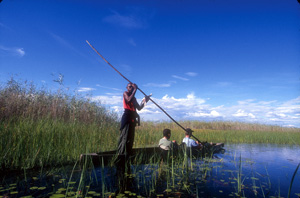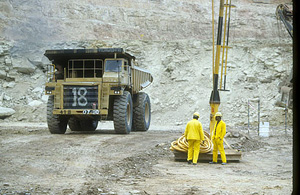When the London sights move to Gaborone, the capital city of
Botswana, by the end of 2013, sightholders will find themselves close to the
diamond mines that are at the heart of their business. Botswana is a unique
African nation with dramatic and beautiful wildlife, complex and captivating
geography and a peaceful history. It can be a harsh land, a place of too little
water or too much, with a sparse population and equally sparse resources —
except for its diamonds. Traveling there for the sights will be a very
different experience from jetting over to London, strolling through its
familiar, centuries-old neighborhoods and dining in its elegant restaurants. In
anticipation of the transition, some global diamond manufacturers and traders
already have set up shop in Gaborone, opening offices and establishing cutting
facilities in the capital city.
The first three diamonds were discovered in a riverbed in
Botswana in 1956 and the discovery of diamonds on a commercially viable scale
occurred in 1967, one year after the country’s independence. Today, the country
is the world’s largest source of rough diamonds, which has transformed its
agricultural-based economy and given the country one of the fastest-growing
economies anywhere.
Government efforts to develop the nation’s downstream
diamond industry have resulted in the planned shift of the sights to this
southern African nation. It is perhaps time to take a closer look at Botswana
and how the country is using its newfound wealth.

|
Okavango Delta, Botswana
|
HISTORY
The first records of Botswana’s inhabitants are cave
paintings that show human habitation some 25,000 to 30,000 years ago. Its
peaceful history can be traced largely to its homogeneous population. Nearly 80
percent of its two million people are Tswana, also known as Setswana. The
Kalanga make up 11 percent and the Basarwa, 3 percent, but all these ethnic
groups are closely related. Both English and Setswana are official languages.
Historically, the people settled their conflicts or concerns through extensive
discussions in meetings called Kgotlas, guided by their traditional leaders.
They had a democratic form of government long before they had a nation. The timeline below traces the key
events that have led to modern Botswana.

|
Orapa mine
|
GEOGRAPHY
A landlocked country nearly the size of Texas, Botswana
borders on South Africa, Namibia and Zimbabwe. It is a land of great extremes.
Much of the country is covered by the Kalahari Desert — whose name literally
means great thirst — a harsh and forbidding place. The northwestern region is
home to the ever-changing Okavango Delta. Long rains feed the rivers that lie
beneath the land of the delta, raising the underground river level until much
of the region is covered with water. The water recedes over several months,
allowing the land to re-emerge. This ebb and flow repeats each year.
Cattle raising is a deep-rooted tradition and a vital part
of the economy. Cattle equate with wealth in many parts of Africa. In Botswana,
the national herd varies between two million and three million, depending on
climatic conditions. Although about half the population is urbanized, most
people maintain a strong connection with their rural past, keeping small herds
of cattle in the countryside.
Gaborone, the capital, is the center of virtually all
economic activity other than tourism and will be the location of all the
Diamond Trading Company Botswana (DTCB )sights. It is situated in the extreme
southeastern corner of Botswana, just nine miles from South Africa.
WHERE ARE THE DIAMONDS?
Debswana operates the country’s four mines. Orapa is the
first and oldest diamond mine in the country. By 2000, an extension had doubled
the mine’s capacity. The Letlhakane pit, 30 miles east of Orapa, was opened in
1976. The massive Jwaneng mine, 70 miles west of Gaborone, is considered the
world’s richest diamond mine in value of recovered diamonds. In 2002,
production began at the Damtshaa mine, just 12 miles east of the Orapa pipe. A
fifth mine, Lerala, approximately 170 miles from Gaborone in the southeast
corner of the nation and owned by DiamonEx Ltd., opened in 2008 but has had
spotty production since then. The mining industry accounts for 36 percent of
Botswana’s gross domestic product (GDP) and 70 percent to 80 percent of export
revenues. For a few months in 2009 during the economic recession, with global
demand for diamonds dramatically lower, mining was suspended or severely
curtailed in Botswana’s mines.
In many ways, Botswana offers the “real” African experience,
a land largely unspoiled by ill-advised development. Maun, located in the north
central part of the country, is the “safari capital” of the nation. Botswanans
have a reputation as a peaceful people, whose government has not been corrupted
by its recent riches. Unlike nearly all other African nations that have been
blessed with great mineral resources, Botswana has managed its diamond wealth
wisely to develop the country, enrich its citizens and improve the overall
standard of living. In this way, wise leadership has been as much a blessing as
diamonds. With its rare combination of diamonds and peace, the country is not
seeing its mineral wealth squandered but using it to prosper.
Circa1000 BC – Bushmen live in the area.
Circa1000 AD – Black Africans, known as Bantu, which included the Tswana
people, arrive, pushing the Bushmen into the Kalahari Desert.
550 AD – Farming settlements arise near the Okavango Delta, in the
northwestern region of the country.
1852 – The Boers begin to invade the country and the Tswana people
seek protection from the British government against the Boers.
1885-1964 – Once invited in, the British settle in as rulers of what
they now call the Protectorate of Bechuanaland.
1948-1956 – Seretse Khama was the foremost native political leader of
the day. He was shunned and exiled for marrying Ruth Williams, a white English
woman, and forced to renounce his royal title as kgosi, or leader of the
Bamangwato people, in order to return to Bechuanaland and fight for
independence.
1965 – First democratic elections are held in Bechuanaland and
Khama becomes prime minister.
Sept. 30, 1966 – Bechuanaland gains independence from England as the Republic
of Botswana with Khama as president and Gaborone as the capital.
1967 – Diamonds are discovered in commercial quantities at Orapa in
east central Botswana, 234 miles north of Gaborone.
1969 – The De Beers Botswana Mining Company, a 50-50 partnership
between De Beers and the government of Botswana, is formed. The company, which
managed all mining activities in the country, is renamed Debswana Mining
Company in 1992.
1972 – Diamonds are discovered in Jwaneng in south central
Botswana, 75 miles west of Gaborone, and production begins there in 1972.
1995 – The Botswana government begins the forced removal of Bushmen
from the Central Kalahari Game Reserve to facilitate diamond mining.
2006 – The Bushmen win the court case challenging their eviction,
and after a series of appeals by both sides, reclaim their land and its water
rights in 2011.
2008 – Botswana launches the Diamond Trading Company Botswana
(DTCB), a 50-50 partnership between the government of Botswana and De Beers, to
oversee sorting, valuing, sales, marketing and distribution of domestically
sourced diamonds.
2009 – South African Diamond Corporation (SAFDICO) launches the
Diamond Technology Park (DTP) complex, a central supply chain cluster housing
various diamond activities, in furtherance of establishing a downstream diamond
industry in Botswana.
Photos by Jason Laure
Article from the Rapaport Magazine - July 2012. To subscribe click here.